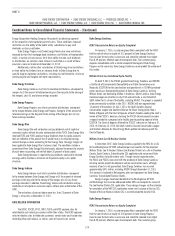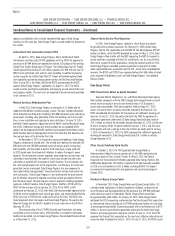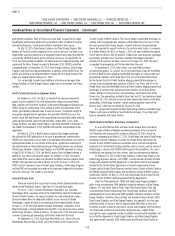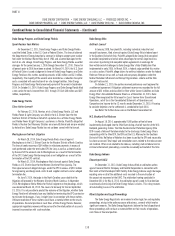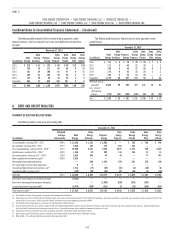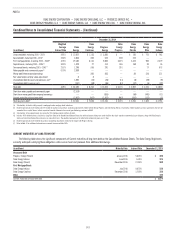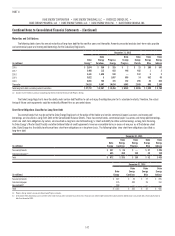Duke Energy 2015 Annual Report Download - page 152
Download and view the complete annual report
Please find page 152 of the 2015 Duke Energy annual report below. You can navigate through the pages in the report by either clicking on the pages listed below, or by using the keyword search tool below to find specific information within the annual report.
132
PART II
DUKE ENERGY CORPORATION • DUKE ENERGY CAROLINAS, LLC • PROGRESS ENERGY, INC. •
DUKE ENERGY PROGRESS, LLC • DUKE ENERGY FLORIDA, LLC • DUKE ENERGY OHIO, INC. • DUKE ENERGY INDIANA, INC.
Combined Notes to Consolidated Financial Statements – (Continued)
In the event of a loss, terms and amounts of insurance available might not
be adequate to cover property damage and other expenses incurred. Uninsured
losses and other expenses, to the extent not recovered by other sources, could
have a material effect on Duke Energy Carolinas’, Duke Energy Progress’ and
Duke Energy Florida’s results of operations, cash flows or financial position.
Each company is responsible to the extent losses may be excluded or exceed
limits of the coverage available.
Nuclear Liability Coverage
The Price-Anderson Act requires owners of nuclear reactors to provide for
public nuclear liability protection per nuclear incident up to a maximum total
financial protection liability. The maximum total financial protection liability,
which is currently $13.5 billion, is subject to change every five years for inflation
and for the number of licensed reactors. Total nuclear liability coverage consists
of a combination of private primary nuclear liability insurance coverage and a
mandatory industry risk-sharing program to provide for excess nuclear liability
coverage above the maximum reasonably available private primary coverage.
The United States Congress could impose revenue-raising measures on the
nuclear industry to pay claims.
Primary Liability Insurance
Duke Energy Carolinas, Duke Energy Progress and Duke Energy Florida
have purchased the maximum reasonably available private primary nuclear
liability insurance as required by law, which currently is $375 million per station.
Excess Liability Program
This program provides $13.1 billion of coverage per incident through
the Price-Anderson Act’s mandatory industrywide excess secondary financial
protection program of risk pooling. This amount is the product of potential
cumulative retrospective premium assessments of $127 million times the
current 103 licensed commercial nuclear reactors in the U.S. Under this
program, licensees could be assessed retrospective premiums to compensate
for public nuclear liability damages in the event of a nuclear incident at any
licensed facility in the U.S. Retrospective premiums may be assessed at a rate
not to exceed $19 million per year per licensed reactor for each incident. The
assessment may be subject to state premium taxes.
Nuclear Property and Accidental Outage Coverage
Duke Energy Carolinas, Duke Energy Progress and Duke Energy Florida
are members of Nuclear Electric Insurance Limited (NEIL), an industry
mutual insurance company, which provides “all risk” property damage,
decontamination, and premature decommissioning insurance for each station
for losses resulting from damage to its nuclear plants, either due to accidents
or acts of terrorism. Additionally, NEIL provides some replacement power
cost insurance for each station for losses in the event of a major accidental
outage at an insured nuclear station. NEIL requires its members to maintain
an investment grade credit rating or to ensure collectability of their annual
retrospective premium obligation by providing a financial guarantee, letter
of credit, deposit premium or other means of assurance. The companies
are required each year to report to the NRC the current levels and sources
of insurance that demonstrate it possesses sufficient financial resources to
stabilize and decontaminate its reactors and reactor station sites in the event of
an accident.
Pursuant to regulations of the NRC, each company’s property damage
insurance policies provide that all proceeds from such insurance be applied,
first, to place the plant in a safe and stable condition after a qualifying accident,
and second, to decontaminate the plant before any proceeds can be used for
decommissioning, plant repair or restoration.
Losses resulting from acts of terrorism are covered as common
occurrences, such that if terrorist acts occur against one or more commercial
nuclear power plants insured by NEIL within a 12-month period, they would
be treated as one event and the owners of the plants where the act occurred
would share one full limit of liability. The full limit of liability is currently $3.2
billion. NEIL sublimits the total aggregate for all of their policies for non-nuclear
terrorist events to approximately $1.83 billion.
Each nuclear facility has accident property damage, decontamination
and premature decommissioning liability insurance from NEIL with limits of
$1.5 billion, except for Crystal River Unit 3. Crystal River Unit 3’s limit is
$1 billion and is on an actual cash value basis. NEIL coverage for Crystal River
Unit 3 does not include property damage to or resulting from the containment
structure although the coverage does apply to decontamination and debris
removal, if required following an accident, to ensure public health and safety or
if property damage results from a terrorism event. All nuclear facilities except
for Catawba and Crystal River Unit 3 also share an additional $1.25 billion
nuclear accident insurance limit above their dedicated underlying limit. This
shared additional excess limit is not subject to reinstatement in the event of
a loss. Catawba has a dedicated $1.25 billion of additional nuclear accident
insurance limit above its dedicated underlying limit. Catawba and Oconee also
have an additional $750 million of non-nuclear accident property damage limit.
All coverages are subject to sublimits and significant deductibles.
NEIL’s Accidental Outage policy provides some replacement power cost
insurance for losses in the event of a major accident property damage outage of
a nuclear unit. Coverage is provided on a weekly limit basis after a significant
waiting period deductible and at 100 percent of the available weekly limits
for 52 weeks and 80 percent of the available weekly limits for the next 110
weeks. Coverage is provided until these available weekly periods are met where
the accidental outage policy limit will not exceed $490 million for McGuire,
Catawba, Oconee, Brunswick, and Harris and $457 million for Robinson. NEIL
sublimits the accidental outage recovery to the first 104 weeks of coverage
not to exceed $328 million from non-nuclear accidental property damage.
Coverage amounts decrease in the event more than one unit at a station is out
of service due to a common accident. All coverages are subject to sublimits and
significant deductibles.
Potential Retroactive Premium Assessments
In the event of NEIL losses, NEIL’s board of directors may assess
member companies retroactive premiums of amounts up to 10 times their
annual premiums for up to six years after a loss. NEIL has never exercised this
assessment. The maximum aggregate annual retrospective premium obligations
for Duke Energy Carolinas, Duke Energy Progress and Duke Energy Florida
are $159 million, $108 million and $7 million, respectively. The maximum
assessment amounts include 100 percent of Duke Energy Carolinas’ and
Duke Energy Florida’s potential obligations to NEIL for their share of jointly
owned reactors.
ENVIRONMENTAL
Duke Energy is subject to international, federal, state and local regulations
regarding air and water quality, hazardous and solid waste disposal and other
environmental matters. The Subsidiary Registrants are subject to federal, state
and local regulations regarding air and water quality, hazardous and solid waste




